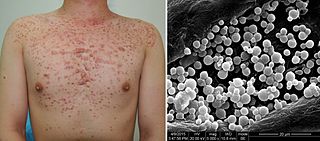Related Research Articles

Vitiligo is a long-term skin condition characterized by patches of the skin losing their pigment. The patches of skin affected become white and usually have sharp margins. The hair from the skin may also become white. The inside of the mouth and nose may also be involved. Typically both sides of the body are affected. Often the patches begin on areas of skin that are exposed to the sun. It is more noticeable in people with dark skin. Vitiligo may result in psychological stress and those affected may be stigmatized.

Sebaceous glands are microscopic exocrine glands in the skin that secrete an oily or waxy matter, called sebum, to lubricate and waterproof the skin and hair of mammals. In humans, they occur in the greatest number on the face and scalp, but also on all parts of the skin except the palms of the hands and soles of the feet. The type of secretion of the sebaceous glands is referred to as holocrine. In the eyelids, meibomian glands, also called tarsal glands, are a type of sebaceous gland that secrete a special type of sebum into tears. Areolar glands surrounding the female nipples are another example of sebaceous gland.

Nevus is a nonspecific medical term for a visible, circumscribed, chronic lesion of the skin or mucosa. The term originates from nævus, which is Latin for "birthmark", however, a nevus can be either congenital or acquired. Common terms, including mole, birthmark, and beauty mark, are used to describe nevi, but these terms do not distinguish specific types of nevi from one another.

Epidermolysis bullosa simplex (EBS), is a disorder resulting from mutations in the genes encoding keratin 5 or keratin 14.
Prurigo gestationis is an eruption consisting of pruritic, excoriated papules of the proximal limbs and upper trunk, most often occurring between the 20th and 34th week of gestation.

Acrokeratoelastoidosis of Costa is a familial condition characterized by multiple keratotic papules on the dorsum of the hands and feet, palms, soles, in which electron microscopy shows rarified, abnormal elastic tissue.
Keratosis pilaris atrophicans faciei begins in infancy as follicular papules with perifollicular erythema. Initially, the lesions are restricted to the lateral eyebrows, but with time spread to involve the cheeks and forehead, and may also be associated with keratosis pilaris on the extremities and buttocks.
Galli–Galli disease is a rare inherited condition that has close resemblance clinically to Dowling-Degos' disease, but is histologically distinct, characterized by skin lesions that are 1- to 2-mm slightly keratotic red to dark brown papules which are focally confluent in a reticulate pattern. The disease is also characterized by slowly progressive and disfiguring reticulate hyperpigmentation of the flexures, clinically and histopathologically diagnostic for Dowling-Degos disease but also associated with suprabasal, nondyskeratotic acantholysis.
Lichen striatus is a rare skin condition that is seen primarily in children, most frequently appearing ages 5–15. It consists of a self-limiting eruption of small, scaly papules.
Centrifugal abdominal lipodystrophy is a skin condition characterized by areas of subcutaneous fat loss that slowly enlarge.
Primary inoculation tuberculosis is a skin condition that develops at the site of inoculation of tubercle bacilli into a tuberculosis-free individual.
Gougerot–Blum syndrome is a variant of pigmented purpuric dermatitis, a skin condition characterized by minute, rust-colored to violaceous, lichenoid papules that tend to fuse into plaques of various hues. Relative to other variants, it is characterized clinically by a male predominance, pruritus, with a predilection for the legs, and histologically, it features a densely cellular lichenoid infiltrate.

Friction blisters are a skin condition that may occur at sites of combined pressure and friction, and may be enhanced by heat, moisture, or cotton socks. Friction blisters are characterized by vesicles or bullae.
Black heel and palm is a skin condition characterized by a sudden shower of minute, black, punctate macules occurring most often on the posterior edge of the plantar surface of one or both heels.

Pityrosporum folliculitis or Malassezia folliculitis is a skin condition caused by infection by pityrosporum yeast.
Necrobiotic xanthogranuloma is a multisystem disease that affects older adults, and is characterized by prominent skin findings.
Benign cephalic histiocytosis not to be confused with "Neonatal cephalic pustulosis" is a rare skin condition affecting boys and girls equally, characterized by skin lesions that initially present on the head in all cases, often the cheeks, eyelids, forehead, and ears.
Multicentric reticulohistiocytosis is a multisystem disease beginning usually around the age of 50 years, and is twice as common in women.
A diabetic bulla is a cutaneous condition characterized by a noninflammatory, spontaneous, painless blister, often in acral locations, seen in diabetic patients.
Diabetic dermadromes constitute a group of cutaneous conditions commonly seen in people with diabetes with longstanding disease. Conditions included in this group are:
References
- ↑ Rapini, Ronald P.; Bolognia, Jean L.; Jorizzo, Joseph L. (2007). Dermatology: 2-Volume Set. St. Louis: Mosby. ISBN 978-1-4160-2999-1.
- ↑ James, William D.; Berger, Timothy G.; et al. (2006). Andrews' Diseases of the Skin: clinical Dermatology. Saunders Elsevier. ISBN 978-0-7216-2921-6.